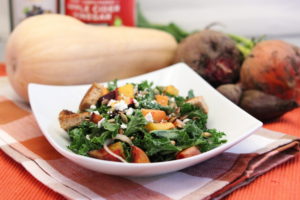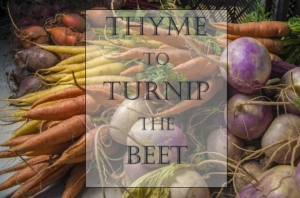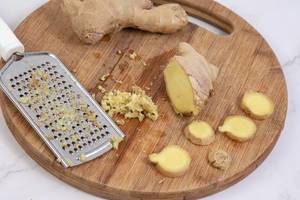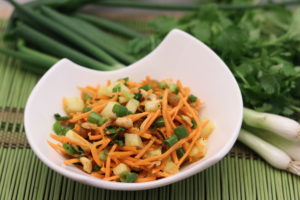 What comes to mind when you hear “root vegetables?”
What comes to mind when you hear “root vegetables?”
Some might say “intimidating” or “I am not even really sure which vegetables make the root vegetable list.” And, of course, the most common…“I have no idea what to do with most of those strange-looking veggies!”
The reality is root vegetables can be absolutely delicious and, because they absorb significant nutrients from the soil, they are VERY good for us! (And, yes, we will show you how to make them taste fantastic to blow away that “they taste like dirt” perception!)
To help you understand more about these veggies and how to enjoy them, following are some guidance and great-tasting ideas for a variety of root vegetables…so you don’t feel like you “just fell off the turnip truck!” (Couldn’t resist…had to find a way to get that in there!)
What are root vegetables?
Plant roots we can – and should – eat! Root vegetables grow underground. Because they absorb so many nutrients from the soil, they are super healthy and nutritious! If eating in-season is important to you (and we really hope it is), then you should be enjoying root vegetables right now! When they are in-season, the roots tend to grow deeper and the flavor tends to be sweeter. Root vegetable peak season is October through February, although several are able to grow almost year-round.
What are the most common root vegetables?
 Carrots, sweet potatoes, potatoes, ginger root, kohlrabi, parsnips, rutabaga, beets, turnips, radishes, onions, garlic and jicama.
Carrots, sweet potatoes, potatoes, ginger root, kohlrabi, parsnips, rutabaga, beets, turnips, radishes, onions, garlic and jicama.
How can you cook them?
Most root vegetables can be eaten raw, but many are so hard they are best when they are cooked. To cook them, grilling, roasting, sautéing and steaming are great options.
We get several questions about root vegetables, particularly about the differences among varieties. Here are a few possibly not-so-well-known tips about some of these veggies:
 What is the difference between a yam and a sweet potato?
What is the difference between a yam and a sweet potato?
We often see “yams” at the store alongside the sweet potatoes, but typically those are not truly yams – they are simply another variety of sweet potatoes. Sweet potatoes can come in two forms, soft and firm and, in our U.S. grocery stores, the soft form is what is typically considered to be a “yam.” True yams have a black/brown bark-like skin and a white, purple or red inside flesh, and are most likely only found at specialty stores.
So, whether you purchase sweet potatoes or yams at the store depends on how you want to cook them. If you are boiling or steaming, go ahead and pick up the soft form, or yams. For grilling, roasting, or sautéing, pick up the firm form, or sweet potatoes. Either way, the taste will be very similar.
What is the difference between a turnip and rutabaga?
Turnips and rutabaga are both from the same family of root vegetables and look very similar. Rutabaga are typically larger, slightly sweeter, and have a more yellow colored flesh inside. Rutabaga are a cross between a cabbage and a turnip. Both should probably be peeled before cooking because the skin can be tough and bitter. Occasionally, if you find young turnips with a thin skin, you won’t need to peel them.
 How do you use a ginger root?
How do you use a ginger root?
When you want to add ginger flavor, ginger root is a great alternative to ground ginger. Simply peel and then grate the fresh ginger…you will notice a huge pop of flavor! One tablespoon of fresh ginger is equivalent to 1/4 tsp of ground ginger. Check out a short video about our favorite ginger root trick — when you store it in the freezer, your fresh ginger will never go bad!
You will want to continue to use ground ginger in baking, but try fresh ginger in savory dishes — it works great in Asian inspired meals. Try the Stir-Fried Greens with Jalapeño and Ginger or the Sunshine Pineapple Rice. Keep in mind, ginger consumed in normal amounts is completely safe, but if consumed in large amounts, it can interact with some medications or medical conditions, and it can also slow down blood clotting. See our coaching tip for more about ginger!
Ready for just a few of the incredibly delicious ways to enjoy root vegetables?
- Carrots – of course most of us just eat them raw, but have you ever roasted carrots? Amazing! Try Roasted Beets and Carrots with Goat Cheese Vinaigrette or Moroccan Roasted Carrots.
 Sweet Potatoes – whenever we hear someone say they don’t like sweet potatoes, our next question is always…”have you had them other than at Thanksgiving with marshmallows and brown sugar?” Sweet potatoes are not really that sweet…there are endless spectacular ways to prepare them! Here are just a few favorites: Sweet Potatoes with Pecans and Goat Cheese, Sweet Potato Hash with Egg on Top, Chipotle Steak Fajita Stuffed Sweet Potato and Spicy Peanut Sweet Potato Soup.
Sweet Potatoes – whenever we hear someone say they don’t like sweet potatoes, our next question is always…”have you had them other than at Thanksgiving with marshmallows and brown sugar?” Sweet potatoes are not really that sweet…there are endless spectacular ways to prepare them! Here are just a few favorites: Sweet Potatoes with Pecans and Goat Cheese, Sweet Potato Hash with Egg on Top, Chipotle Steak Fajita Stuffed Sweet Potato and Spicy Peanut Sweet Potato Soup.
- Potatoes – potatoes often get a bad rap, but when eaten in their original form and prepared in a great-tasting, healthful way, they can actually be good for you! Check out the Great Potato Debate coaching tip to learn more! And then try Honey Dijon Roasted Potatoes with Rosemary or the Grilled Potato Salad with Chimichurri Dressing.
 Kohlrabi – this alien-looking vegetable may look intimidating, but it is completely worth the effort to add it to salads or stir-fry dishes. See our coaching tip…Looks Can Be Deceiving. Considered the “poor man’s water chestnut,” kohlrabi tastes similar to a mild radish. Try Pork Chops with Apple Kohlrabi Slaw or Simple Sautéed Vegetables.
Kohlrabi – this alien-looking vegetable may look intimidating, but it is completely worth the effort to add it to salads or stir-fry dishes. See our coaching tip…Looks Can Be Deceiving. Considered the “poor man’s water chestnut,” kohlrabi tastes similar to a mild radish. Try Pork Chops with Apple Kohlrabi Slaw or Simple Sautéed Vegetables.
- Parsnips – an absolute favorite (that even makes the birthday request list in our house) is Parsnip Fries! This cream-colored carrot looking vegetable is crazy good roasted because it caramelizes and becomes sweet as it cooks. It can also be added to soups and stews. Check out the Honey Dijon Roasted Carrots & Parsnips!
 Beets – a lot of people “think” they don’t like beets, but many Eat REAL America members have discovered a new love for beets thanks to some of these sides. Beets don’t have to taste like the pickled version on salad bars — try roasting them – it may make you a believer (if you are not already)! Check out the Roasted Beet Hummus, Autumn Roasted Veggie Sandwich or Roasted Beets with Walnuts and Gorgonzola.
Beets – a lot of people “think” they don’t like beets, but many Eat REAL America members have discovered a new love for beets thanks to some of these sides. Beets don’t have to taste like the pickled version on salad bars — try roasting them – it may make you a believer (if you are not already)! Check out the Roasted Beet Hummus, Autumn Roasted Veggie Sandwich or Roasted Beets with Walnuts and Gorgonzola.
- Turnips – have you ever tried Grilled Turnips? That was a game-changer for us! We thought turnips were bitter, sour and had to be boiled…were we wrong! When you grill or roast them, they become sweet and flavorful! You can also add them with potatoes and mash for a super delicious side dish!
 Jicama – sometimes referred to as a Mexican water chestnut, jicama has a sweet mild taste, similar to an apple. It is a great addition to stir-fry dishes because is stays crisp as it cooks…perfect when you want a little crunch! See what we mean with Jicama Fries, Sweet Curried Carrot Salad or Turkey Salad with Spicy Avocado Dressing — great for holiday leftovers!
Jicama – sometimes referred to as a Mexican water chestnut, jicama has a sweet mild taste, similar to an apple. It is a great addition to stir-fry dishes because is stays crisp as it cooks…perfect when you want a little crunch! See what we mean with Jicama Fries, Sweet Curried Carrot Salad or Turkey Salad with Spicy Avocado Dressing — great for holiday leftovers!
We did a cooking class on root vegetables and were blessed to witness first-hand some slightly skeptical attendees become root vegetable believers!
We made Roasted Beet Hummus, Autumn Panzanella Salad, Savory Root Vegetable Soup and also Mashed Potatoes and Turnips with Sautéed Leeks. Here are a few things we heard from the participants:
 “I loved being able to try kohlrabi and parsnips…and also loved the beet hummus!”
“I loved being able to try kohlrabi and parsnips…and also loved the beet hummus!”
“I can’t believe it…I actually like beets and parsnips!”
“Who knew you could include turnips in a mashed potato dish? I was pleasantly surprised how good root vegetables can taste!”
“I am so excited I found a new dish to serve our family for the holidays!”
Zonya’s Take:
While all root vegetables are superstars for our health, the bright purple color (and deep green leaves…yes, they are delicious too) of beets screams “blood-empowering nutrition,” which defends us from the ravages of aging. More specifically, beets receive their super food status because of their detoxification benefits. Betalin pigments in beets “hook up” with an enzyme family called glutathione-S-transferase (GST’s), which together effectively neutralize toxins and makes them water soluble for excretion in the urine. If you are a person who thinks about exposure to toxins and wants to give your body as much detox support as possible, beets are a food that belong in your diet! There are many ways to enjoy beets: shredded raw and added to salads; juiced in a juicer or added to smoothies; or quartered and steamed with the skins on for 15 minutes (then rub the skin off after cooled), or ROASTED…our favorite way! You can use kitchen gloves or paper towel to prevent staining of your hands. Any way you eat them, raw, juiced, steamed, marinated or roasted, I guarantee that you are in for not only a delight to the taste buds, but overall healthy detoxification.
Hopefully these ideas will help you take advantage of these nutritious root vegetables now while they are in-season!
Please share your great-tasting ideas for your favorite root vegetables!








Leave A Comment